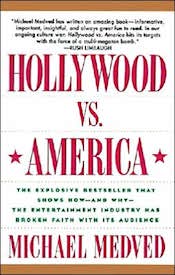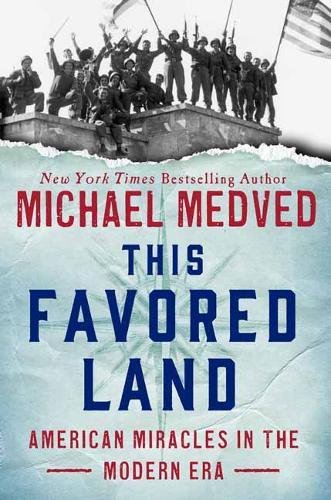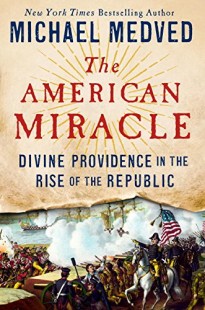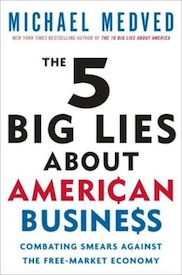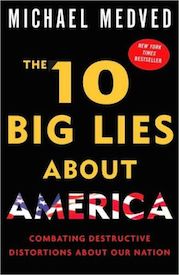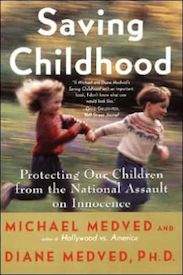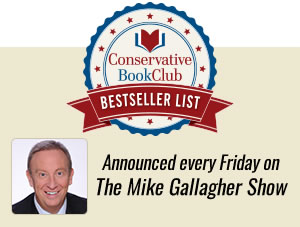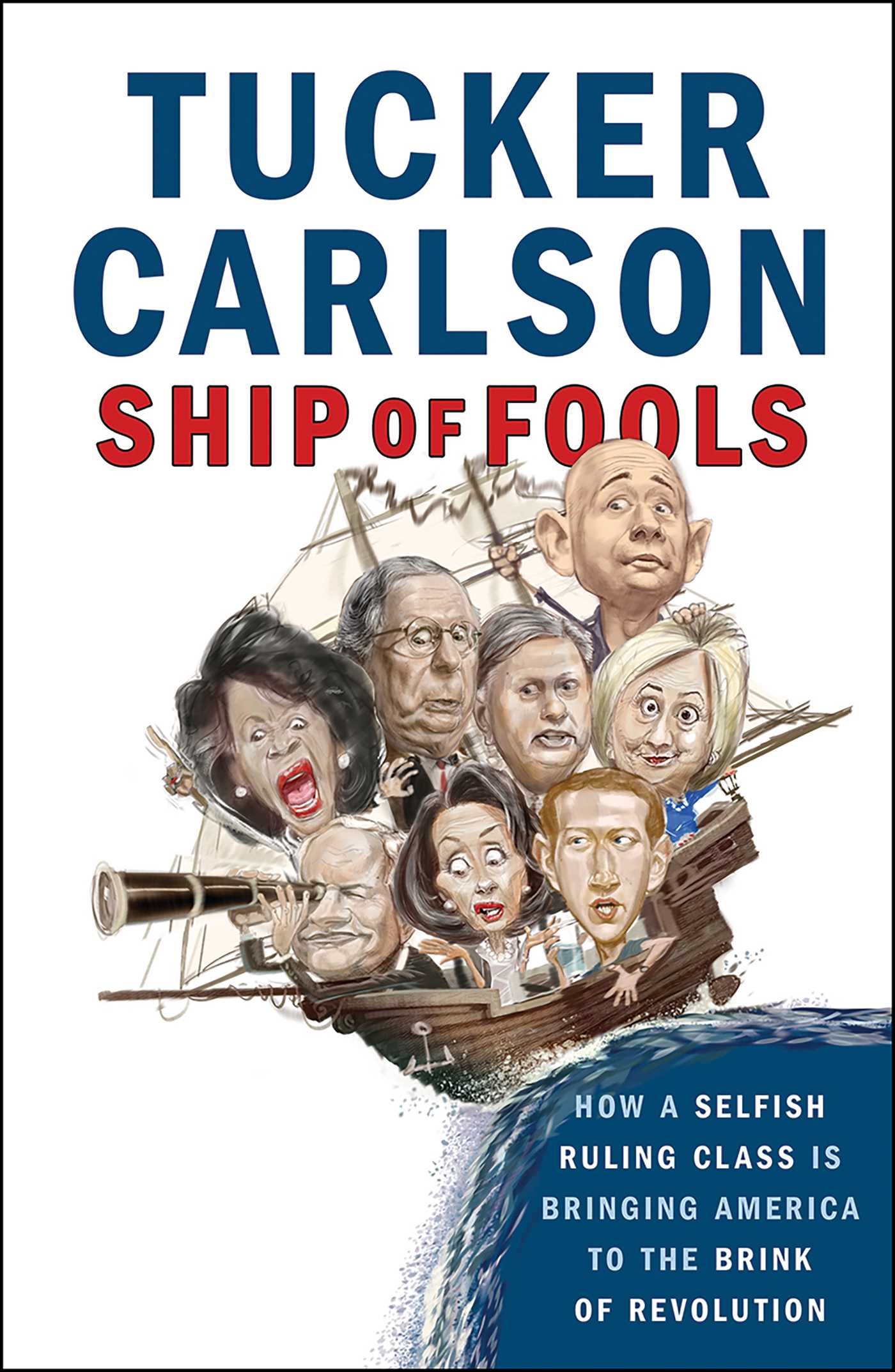Hollywood vs. America: Popular Culture And The War on Tradition
Hollywood vs. America is a passionate and immensely readable polemic about the entertainment industry’s self-destructive assault on the ideas and mores of its American audience. Michael Medved, the affably innocuous co-host of the weekly PBS movie-review show, Sneak Previews, here shows little evidence of his TV persona; instead, his plainspoken book combines eye-opening research, encyclopedic detail, and sophisticated analysis to explain how Hollywood’s alienation from traditional values is itself alienating American moviegoers and television viewers.
Given the intensive focus these days on the American entertainment industry, one might think that movies were more popular than ever, and that more people were watching television than ever. Medved demonstrates that neither is true. Movie attendance is half what it was 30 years ago, while the network-television audience is a third smaller than it was 15 years ago. Even such new forms of entertainment as video rentals are down, with a startling 6-percent decline in 1991 alone.
Whenever the entertainment industry is in trouble, it usually blames tough economic times. Today’s film-studio bosses also blame their predecessors for choosing lousy projects, and network executives blame the advent of cable. All believe that success is unpredictable, and are fond of citing the screenwriter William Goldman’s dictum that “nobody knows anything” about what makes money at the box office. Yet Medved believes he knows the answer: Hollywood is willfully blind to America’s growing disaffection with its wares.
Medved, an Orthodox Jew, begins with religion. Present-day Hollywood pays obeisance to a fashionable paganism, ranging from New Age pseudo-spirituality to American Indian mysticism—as befits “a community in which Shirley MacLaine has more followers than either Moses or Jesus.” At the same time, the entertainment industry “regularly ridicules religious believers as crooks or crazies.” Here is a Hollywood producer on the decision to spend some $30 million on a 1985 epic about King David: “‘We wanted to make a film with guts. We wanted to do it with integrity. We don’t see David as some Holy Joe, praise-the-Lord kind of guy.’”
Turning the author of the Psalms into an atheist helped earn King David its reputation as one of the notorious flops of the 1980’s, but not the only one whose failure can be traced directly or indirectly to an offending portrayal of religion on screen. Medved cites dozens of comparable examples, summarizing their plots in the profoundly ironical voice he devised for his two hilarious books about bad movies, The Golden Turkey Awards and Son of the Golden Turkey Awards. As for movies with a positive religious message over the past decade, he comes up with a total of exactly seven.
The bizarre thing about this Hollywood fashion, especially given the fact that every week 78 million Americans attend church while only 19 million go to the movies, is that it has proved financially ruinous:
The cinematic assaults on religion have lost hundreds of millions for the people who made them, but the major studios . . . persist in throwing good money after bad.
Medved sees “a perverse sort of idealism” in this peculiar approach to the principle of economic self-interest:
For many of the most powerful people in the entertainment business, hostility to organized religion goes so deep and burns so intensely that they insist on expressing that hostility, even at the risk of financial disaster. . . . It is clear that a powerful prejudice is at work.
Medved’s most original insights have to do with the growing display of moral and spiritual ugliness on screen, expressions of an anarchic streak which, more than anything else, defines today’s Hollywood ethos. Cinematic characters now regularly vomit and urinate on screen, presumably for no other reason than to impress upon the viewer the harsh nature of reality. There has even been a recent Hollywood obsession with cannibalism (though, with the exception of The Silence of the Lambs, movies featuring the practice have understandably flopped). And of course the language used has become progressively more obscene. In 1991, Medved reports, “the average R-rated movie contain [ed] 22 F-words, 14 S-words, and 5 A-words—providing its viewers with a major obscenity every two-and-a-half minutes.” Movies aimed at least in part at children are not much better:
I am always amazed at how many parents still cling to the notion that a PG or PG-13 rating for a film means that their children will be spared the most intense obscenities. This supposition hardly squares with the fact that 39 percent of 1991 PG-13 films used the F-word, 66 percent used the A-word, and an amazing 73 percent used the S-word!
To Hollywood, the only real transcendence afforded in life is sex—and not marital sex, either. According to a 1988 study by Planned Parenthood, the three major television networks broadcast a total of more than 65,000 sexual references annually—or 27 an hour. A 1981 study analyzing one episode of each network series “found 41 instances of sexual intercourse outside of marriage, and only six references to intercourse between married people.” Although Americans in overwhelming numbers get married and stay married, and believe marriage is an unvarnished good, Hollywood insists on portraying marriage as a failing or failed institution.
For Medved, there are clear ideological and even spiritual consequences to this misreading of the national condition:
The emphasis on disastrous relationships, and the paucity of positive alternatives, contribute powerfully to the prevailing sense that marriage is an institution under siege; that happy couples are an endangered species; that misery and cruelty are inevitable byproducts of the traditional family structure.
The same feelings of instability are engendered by Hollywood’s obsession with violence and crime. Television characters are murdered at a rate a thousand times greater than people in real life. Medved concedes that crime will, for understandable reasons, always be “overrepresented in popular entertainment,” but warns that “the ominous view of the world conveyed by the popular culture contributes powerfully to the insecurity and paranoia that in turn facilitate increased levels of criminal activity.” Unfortunately, he also resorts to some shaky social science attempting to demonstrate a direct relation between crime on screen and an increase in criminal behavior among America’s youth. The studies he cites are interesting and sobering, but hardly definitive.
The central point of Hollywood vs. America is, however, unassailable: not only is there a gaping chasm between Hollywood’s America and the real America, but Hollywood seems willing to pay in the coin of reduced profits for its continued refusal to bridge the chasm. In 1990, four times as many R movies were made as G or PG movies combined. In 1991, 61 percent of the movies released were rated R. Yet according to a statistical study done especially for this book, “since 1980 . . . a given G or PG film is nearly five times more likely to place among the year’s box-office leaders than an R film.” In general, movies rated R “generate substantially less revenue, return less profit, and are more likely to ‘flop’ than films aimed at teen and family audiences.”
These statistics “destroy the arguments that the industry’s longstanding and hugely unbalanced emphasis on ‘adult’ fare is dictated by financial self-interest.” Whether or not they think their beliefs and attitudes mirror those of the American people, Hollywood’s leading lights are doing what they do because they believe in it.
The comedian Jackie Mason once offered a memorable comment on Hollywood’s obsession with explicit sex:
People say you have to have sex in every picture because it reflects real life. But I say, people also have soup. I never heard anybody in a movie say, “I’m looking for a nice plate of soup.”
The last four years have been, without question, the worst in Hollywood history. Moviegoing has become a profoundly unsatisfying experience. Michael Medved has diagnosed the cause and suggested a very reasonable solution: less sex, more soup.
Book Review from Commentary, by John Podhoretz
Tags: Hollywood vs. America: Popular Culture And The War on Tradition, Michael Medved
- The Author

Michael Medved
Michael Medved is a nationally syndicated radio talk show host and bestselling author. Born in Philadelphia, Michael attended public schools […] More about Michael Medved.
- Books by the Author
- Related Articles

Is America God’s Chosen Nation? Listen To Find Out
Is America the beneficiary of God's favor? Listen to History Unplugged's interview with conservative author and radio host Michael Medved[...]




